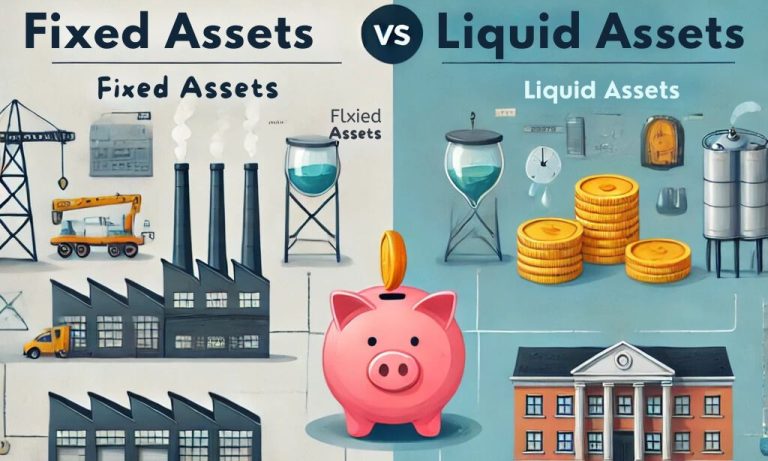The difference between fixed assets and liquid assets is crucial for understanding a company’s financial position. Fixed assets represent long-term resources used in business operations. In contrast, liquid assets are those short-term resources that can easily be converted into cash. Both serve different ends in a company’s strategy, financial health, and decision-making processes. This article seeks to explore the meaning, characteristics, and differences between these asset types to enhance your knowledge about finances.
What is Fixed Assets?
Fixed assets refer to long-term tangible or intangible resources owned by a company and used in its operations. These assets are not meant for resale but for generating revenue over an extended period. Examples include buildings, machinery, vehicles, and patents.
Key Features of Fixed Assets
Fixed assets are an absolute resource of any business for the simple reason that they support the long-term operations of such a business and therefore generate sustained revenues. They are, by definition, not sold and represent a critical component of strategy attainment.
- Long-Term Use: Fixed assets are designed for use over an extended period, typically more than one accounting cycle. They are retained by the business to support operations and are not intended for immediate disposal. This long-term nature makes them vital for the continuity and growth of the organization.
- Tangible or Intangible: Fixed assets can be either tangible or intangible. Tangible fixed assets include physical items such as machinery, buildings, and equipment, which are visible and have a concrete form. Intangible fixed assets, like trademarks, patents, and goodwill, lack a physical presence but hold significant value for the business, often providing legal or competitive advantages.
- Depreciation: Most fixed assets, with the notable exception of land, experience depreciation over time. Depreciation reflects the gradual loss of value due to usage, wear and tear, or obsolescence. This process is accounted for annually to reflect the true value of the assets in financial statements.
- Non-Liquid: Fixed assets are non-liquid, meaning they cannot be quickly converted into cash without disrupting business operations. Selling or liquidating these assets often involves a lengthy process and could impact the organization’s ability to function effectively.
Types of Fixed Assets
Fixed assets are long-term resources critical for a business’s operations, contributing to revenue generation and overall growth.
- Tangible Fixed Assets: Tangible fixed assets are physical assets in the form of equipment, machines, buildings, furniture, and land. Fixed assets can be used to conduct operations that generate revenue. However, most do not maintain their price over time; only land does. Tangible fixed assets provide long-term value and contribute immensely to daily operations.
- Intangible Fixed Assets: Intangible fixed assets are patents, copyrights, goodwill, and licenses, all non-physical assets that have significant value both legally and in competition. They depreciate, although not through traditional depreciation, but through amortization which has been explained.
What is Liquid Assets?
Liquid assets are short-term resources that can be quickly converted into cash without losing significant value. These assets provide the company with immediate liquidity to meet operational expenses or short-term liabilities. Examples are Cash in hand or at the bank, Marketable securities such as Shares, Debentures, and Accounts receivable.
Key Features of Liquid Assets
Liquid assets are a critical component of financial management, offering immediate accessibility and stability for addressing short-term financial needs or unexpected expenses.
- High Liquidity: Liquid assets are characterized by their ability to be rapidly and easily converted into cash with minimal effort or value loss. This makes them indispensable for addressing urgent financial requirements or emergencies.
- Short-Term Use: These assets are designed to support short-term financial operations, helping businesses and individuals meet daily obligations such as payroll, utility bills, or unforeseen expenses. Their accessibility ensures smooth cash flow and operational continuity.
- Stable Value: Liquid assets typically retain their value during conversion, providing a reliable financial cushion. Unlike volatile investments, assets like cash or accounts receivable maintain consistent worth, making them a dependable resource in times of need.
- No Depreciation: Liquid assets do not lose value over time through depreciation, unlike fixed assets. Their value remains intact, ensuring that they are always available at full worth when liquidated. While some, such as stocks, may experience market fluctuations, they still retain their high liquidity.
Difference Between Fixed Assets & Liquid Assets
The primary distinction lies in their usage and liquidity. Here are five key differences:
Definition
- Fixed Assets: Fixed assets are long-term resources owned by a business that are used in its operations to generate revenue. These assets are not meant for immediate sale and typically remain within the business for more than a year.
- Liquid Assets: Liquid assets, on the other hand, are short-term resources that can be easily converted into cash. They are used to meet immediate financial obligations or emergencies and are characterized by their high liquidity.
Purpose
- Fixed Assets: The primary purpose of fixed assets is to aid in the generation of revenue over an extended period. They play a vital role in the ongoing operations of a business and form the foundation for long-term growth and profitability.
- Liquid Assets: Liquid assets are utilized to address the business’s immediate financial needs. They ensure that the company can meet short-term obligations, such as paying suppliers or covering operational expenses, without delay.
Liquidity
- Fixed Assets: Fixed assets are non-liquid, meaning they are not easily convertible into cash. Liquidating fixed assets, such as selling a building or machinery, often requires significant time and effort.
- Liquid Assets: Liquid assets are highly liquid and can be readily converted into cash without significant loss of value. Their quick accessibility makes them essential for managing day-to-day financial demands.
Depreciation
- Fixed Assets: Most fixed assets, except land, are subject to depreciation over time. Depreciation reflects the wear and tear or reduction in value of these assets as they are used in business operations.
- Liquid Assets: Liquid assets are not subject to depreciation. Their value typically remains stable, though some, like stocks, may fluctuate based on market conditions.
Examples
- Fixed Assets: Examples of fixed assets include machinery, buildings, land, and patents. These items are integral to the operational framework of the business and contribute to long-term value creation.
- Liquid Assets: Examples of liquid assets include cash, stocks, accounts receivable, and other resources that can be easily converted to cash. These assets allow businesses to respond to immediate financial requirements.
| Aspect | Fixed Assets | Liquid Assets |
| Definition | Long-term resources used in operations. | Short-term resources are convertible to cash. |
| Purpose | Generate revenue over time. | Meet immediate financial needs. |
| Liquidity | Non-liquid and not easily convertible. | Highly liquid and easily convertible. |
| Depreciation | Subject to depreciation (except land). | Not subject to depreciation. |
| Examples | Machinery, buildings, patents. | Cash, stocks, accounts receivable. |
Conclusion
A proper difference between fixed and liquid assets is important in financial planning and management. Fixed assets are the most valuable assets for long-term growth and production, while liquid assets ensure smooth daily operations as well as better financial flexibility. Effective management of both assures stability and better chances of opportunity for businesses to meet strategic goals.
Fixed Assets vs Liquid Assets FAQs
What’s the difference between fixed assets and liquid assets?
Fixed assets are long-term and used for operations, while liquid assets are short-term and convertible to cash.
Can fixed assets become liquid assets?
Yes, but it usually requires selling the fixed asset, which can disrupt operations.
What are some examples of liquid assets?
Cash, stocks, accounts receivable, and money market funds.
Why are fixed assets important for a company?
They support production, service delivery, and long-term business growth.
How do liquid assets help in financial emergencies?
Liquid assets provide immediate cash flow to meet urgent liabilities or expenses.


